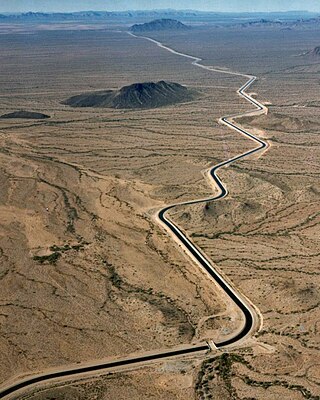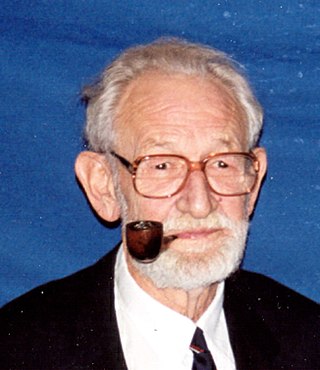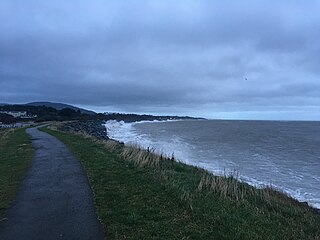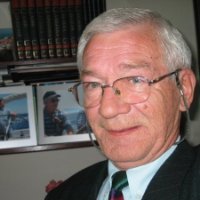
A levee, dike, dyke, embankment, floodbank, or stop bank is an elevated ridge, natural or artificial, alongside the banks of a river, often intended to protect against flooding of the area adjoining the river. It is usually earthen and often runs parallel to the course of a river in its floodplain or along low-lying coastlines.

Hydraulic engineering as a sub-discipline of civil engineering is concerned with the flow and conveyance of fluids, principally water and sewage. One feature of these systems is the extensive use of gravity as the motive force to cause the movement of the fluids. This area of civil engineering is intimately related to the design of bridges, dams, channels, canals, and levees, and to both sanitary and environmental engineering.

The American Society of Civil Engineers (ASCE) is a tax-exempt professional body founded in 1852 to represent members of the civil engineering profession worldwide. Headquartered in Reston, Virginia, it is the oldest national engineering society in the United States. Its constitution was based on the older Boston Society of Civil Engineers from 1848.

In fluid mechanics and hydraulics, open-channel flow is a type of liquid flow within a conduit with a free surface, known as a channel. The other type of flow within a conduit is pipe flow. These two types of flow are similar in many ways but differ in one important respect: open-channel flow has a free surface, whereas pipe flow does not, resulting in flow dominated by gravity but not hydraulic pressure.

The London Avenue Canal is a drainage canal in New Orleans, Louisiana, used for pumping rain water into Lake Pontchartrain. The canal runs through the 7th Ward of New Orleans from the Gentilly area to the Lakefront. It is one of the three main drainage canals responsible for draining rainwater from the main basin of New Orleans. The London Avenue Canal's flood walls built atop earthen levees breached on both sides during Hurricane Katrina in 2005.
Large-scale coastal behaviour is an attempt to model the morphodynamics of coastal change at time and space scales appropriate to management and prediction. Temporally this is at the decade to century scale, spatially at the scale of tens of kilometers. It was developed by de Vriend.
The United States Army Corps of Engineers is involved with a wide spectrum of public works projects: environmental protection, water supply, recreation, flood damage and reduction, beach nourishment, homeland security, military construction, and support to other Governmental agencies. In nineteen (19) different Flood Control Acts since 1917, the United States Congress has authorized the corps to design and build flood protection projects and one risk reduction system in the Greater New Orleans area and throughout the nation.

Hubert Chanson is a professional engineer and academic in hydraulic engineering and environmental fluid mechanics. Since 1990 he has worked at the University of Queensland.

Johannes Aleidis (Johan) Ringers was a Dutch hydraulic engineer and politician. He served as the director-general of Rijkswaterstaat and later as the director of Dutch East Indies Railways. During World War II, Ringers was appointed as the government commissioner for reconstruction, but was later interned by German forces.

Marcel J.F. Stive is a Dutch professor of coastal engineering at the Faculty of Civil Engineering and Geosciences of Delft University of Technology.

In fluid dynamics, the Iribarren number or Iribarren parameter – also known as the surf similarity parameter and breaker parameter – is a dimensionless parameter used to model several effects of (breaking) surface gravity waves on beaches and coastal structures. The parameter is named after the Spanish engineer Ramón Iribarren Cavanilles (1900–1967), who introduced it to describe the occurrence of wave breaking on sloping beaches. The parameter used to describe breaking wave types on beaches; or wave run-up on – and reflection by – beaches, breakwaters and dikes.
Hendrik Lieuwe Tolman is the original developer of the WAVEWATCH III (tm) wind wave model.

Desiderius Gustav Hermann"Dirk"Latzko was a Dutch mechanical engineer. He was a professor of mechanical engineering at Delft University of Technology from 1961 to 1988. Latzko focused on the construction of nuclear reactors.

Eco Wiebe Bijker was a Dutch civil engineer and Professor of Coastal engineering at Delft University of Technology from 1968 until his retirement in 1989.

Wave run-up is the height to which waves run up the slope of a revetment, bank or dike, regardless of whether the waves are breaking or not. Conversely, wave run-down is the height to which waves recede. These heights are always measured vertically. The wave run-up height, denoted by , , or , is a very important parameter in coastal engineering as, together with the design highest still water level, it determines the required crest height of a dike or revetment.

Johannes Theodoor Thijsse was a Dutch hydraulic engineer who made significant contributions to hydraulic engineering both in The Netherlands and internationally. In addition to having a major involvement in the design and planning of both the Zuiderzee Works and the Delta Works, he published widely and played a key role in the establishment of the IHE Delft Institute for Water Education.

Pieter Philippus Jansen was a Dutch civil engineer and hydraulic engineer who made significant contributions to hydraulic engineering in The Netherlands. He spent the majority of his career with Rijkswaterstaat, working on several major projects including the first phase of the Delta Works and leading the reclamation and repair efforts following the inundation of Walcheren.

Krystian Walenty Pilarczyk is a hydraulic engineer whose contributions to civil and hydraulic engineering include the development and improvement of the Izbash formula, along with the Pilarczyk formula for the stability of block revetments. He is the author and editor of a number of academic papers and textbooks on coastal, river, and hydraulic engineering subjects.

Pieter Abraham van de Velde was a Dutch civil engineer and professor of road and hydraulic engineering. He contributed to several major water engineering projects in the Netherlands, notably the drainage of Walcheren at the end of the Second World War, dike restorations following the 1953 North Sea flood, and the Deltaplan.
Herman Arend Ferguson was a Dutch civil engineer and hydraulic engineer who contributed to water management in The Netherlands. He played a central role in the recovery efforts following the inundation of Walcheren in 1944, and the works to repair the significant damage caused by the North Sea flood of 1953. He held senior positions at Rijkswaterstaat, authored several key publications on hydraulic engineering, and was awarded the Order of the Netherlands Lion.
















